Abstract
Two large kindreds with HLA-linked, autosomal dominant spinocerebellar ataxia (SCA1) were examined with markers from chromosome 6p to determine the location of the SCA1 locus. Results of the three-point analysis between the markers HLA-A, SCA1, and F13A overwhelmingly favor the conclusion that SCA1 is located distal of HLA and proximal of F13A. In addition, our data strongly support the conclusion that SCA1 lies centromeric and genetically very close to the highly informative D6S89 marker within the 8-cM chromosomal segment flanked by the D6S88 and D6S89 markers. In the two kindreds, one recombinant was observed between D6S89 and SCA1, resulting in a recombination fraction of .014 between the two loci.
Full text
PDF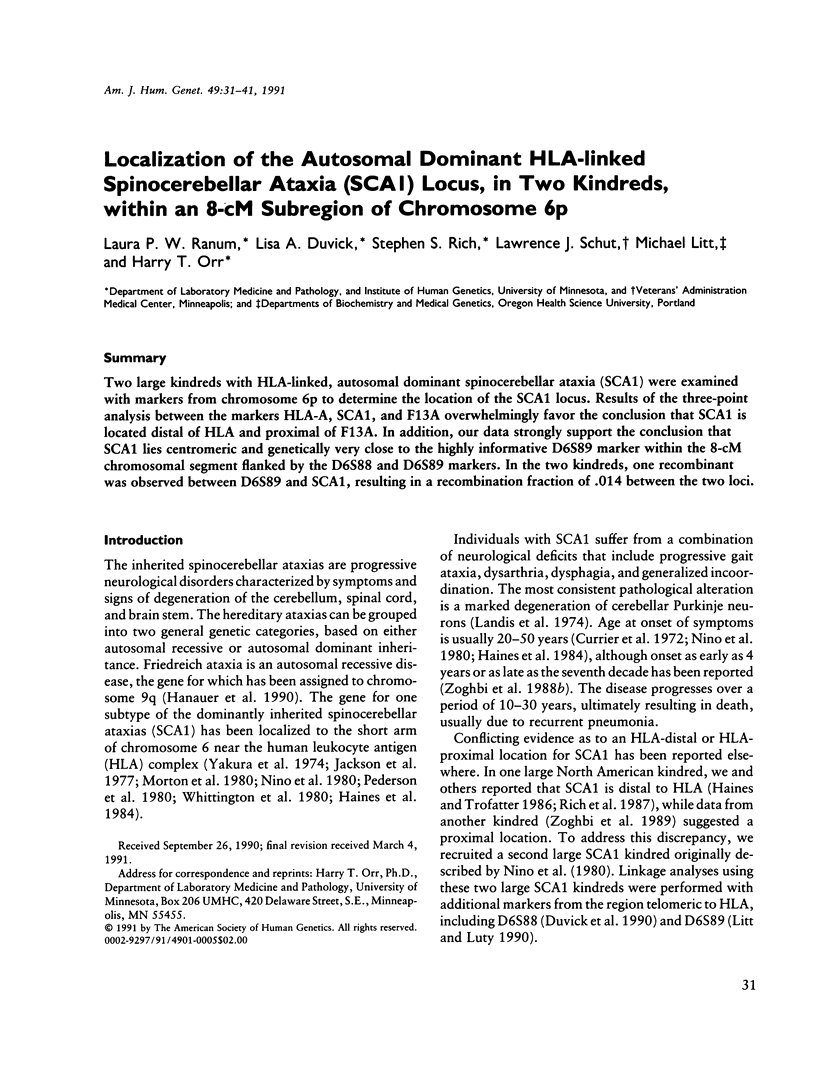
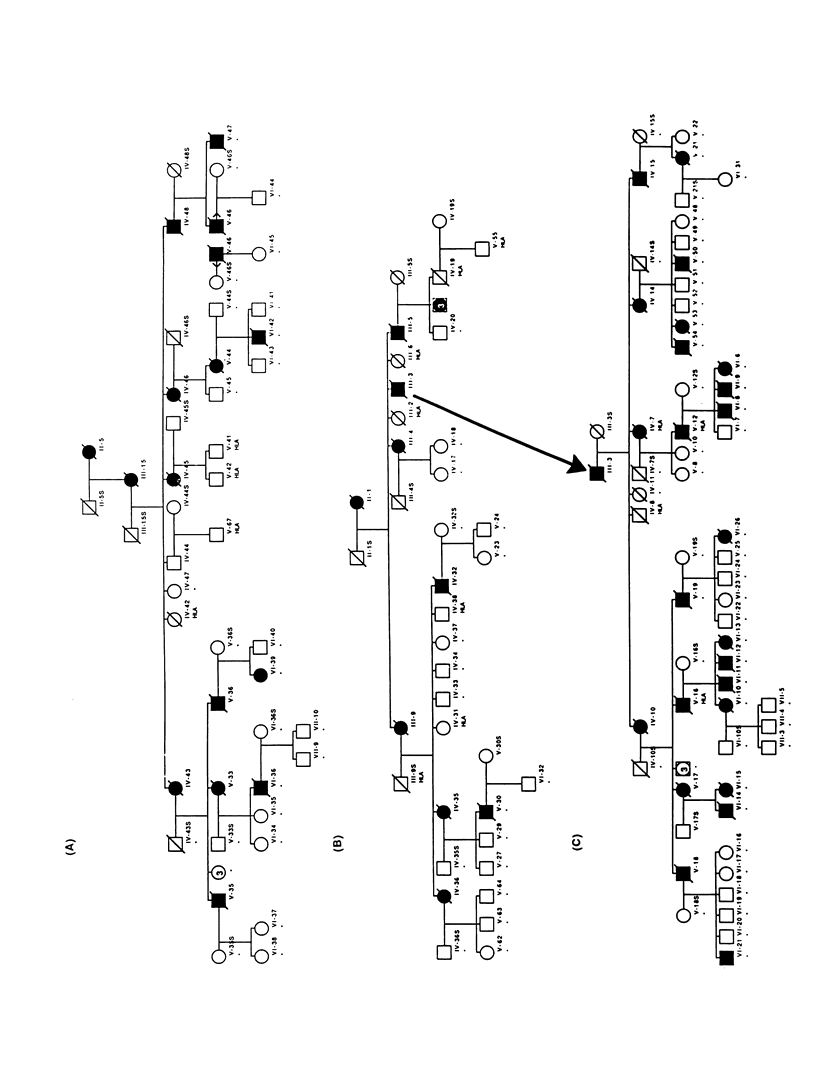
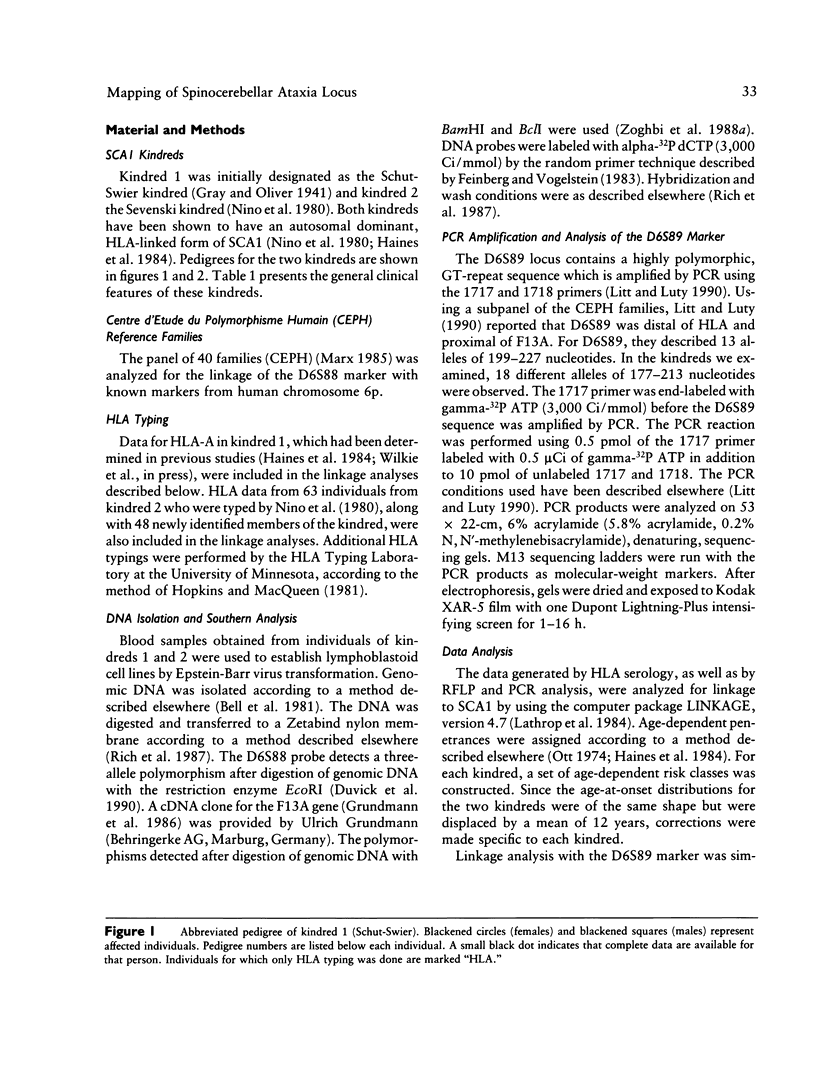

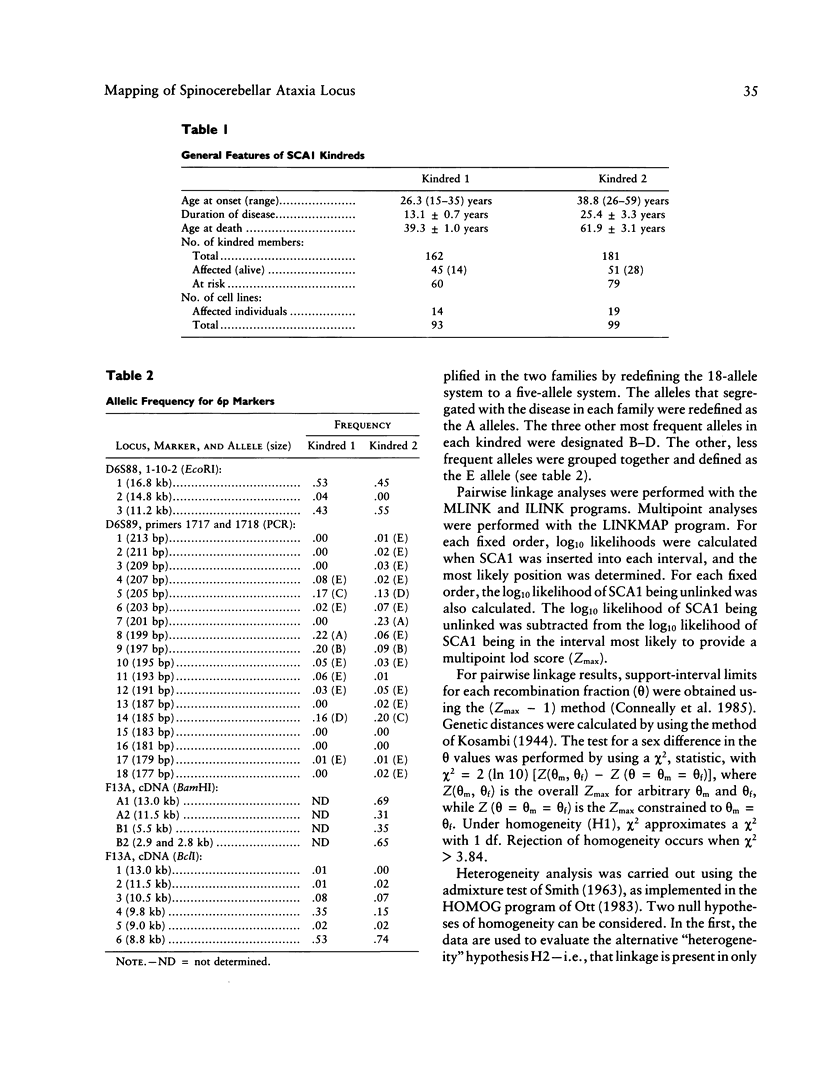
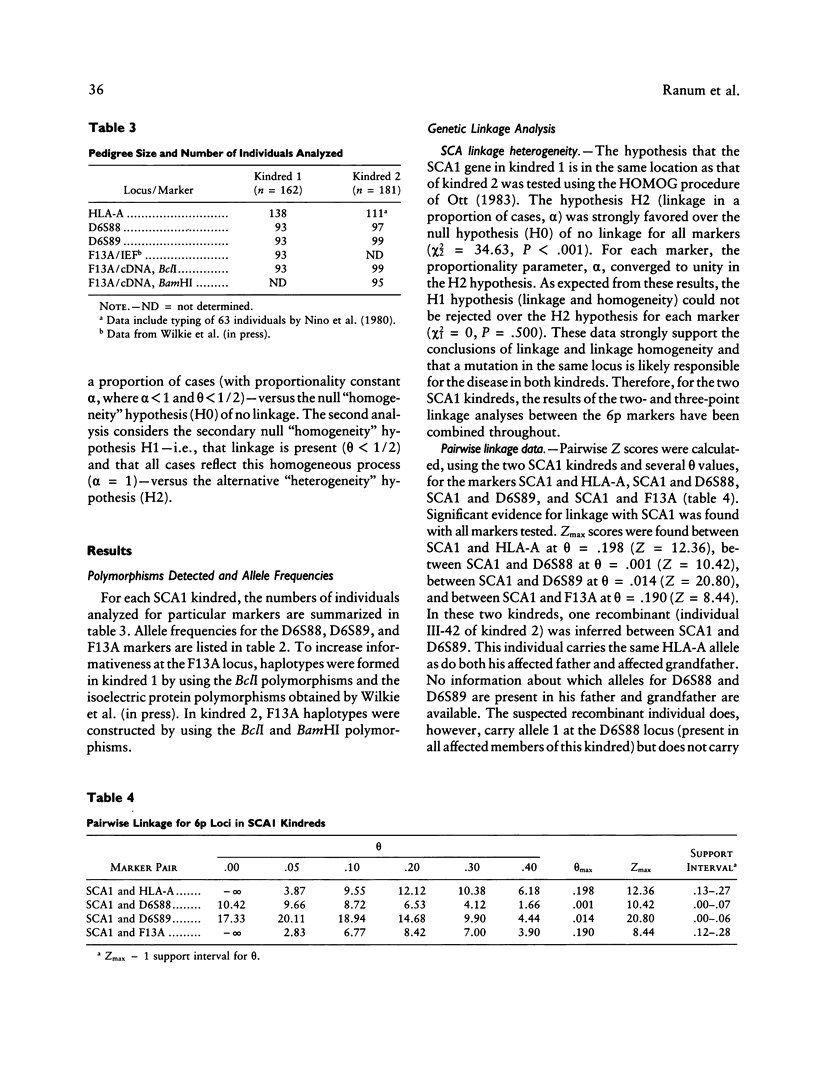
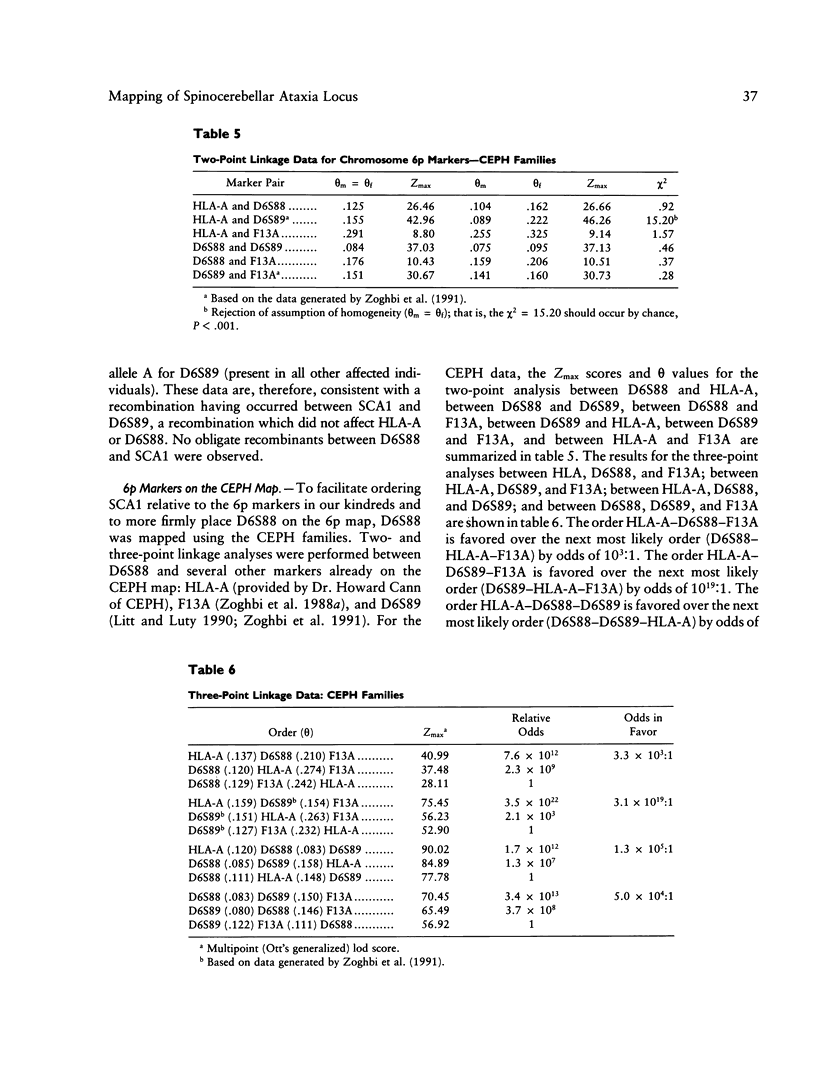
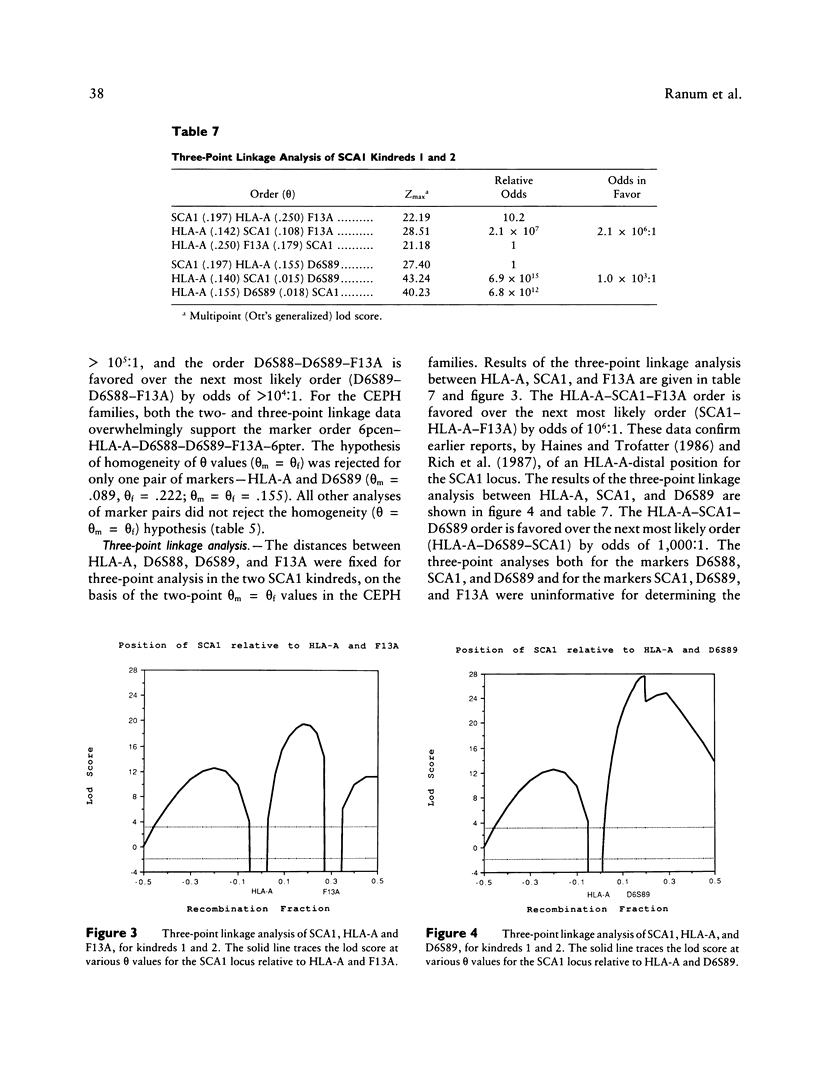
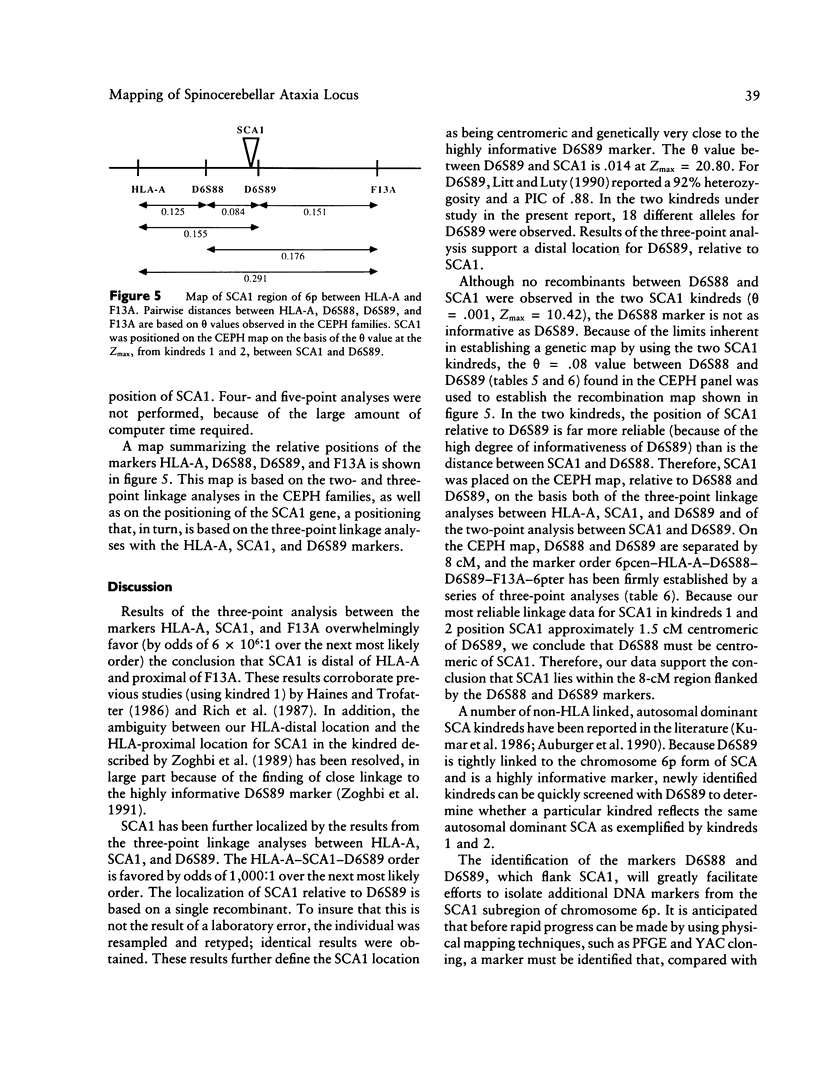

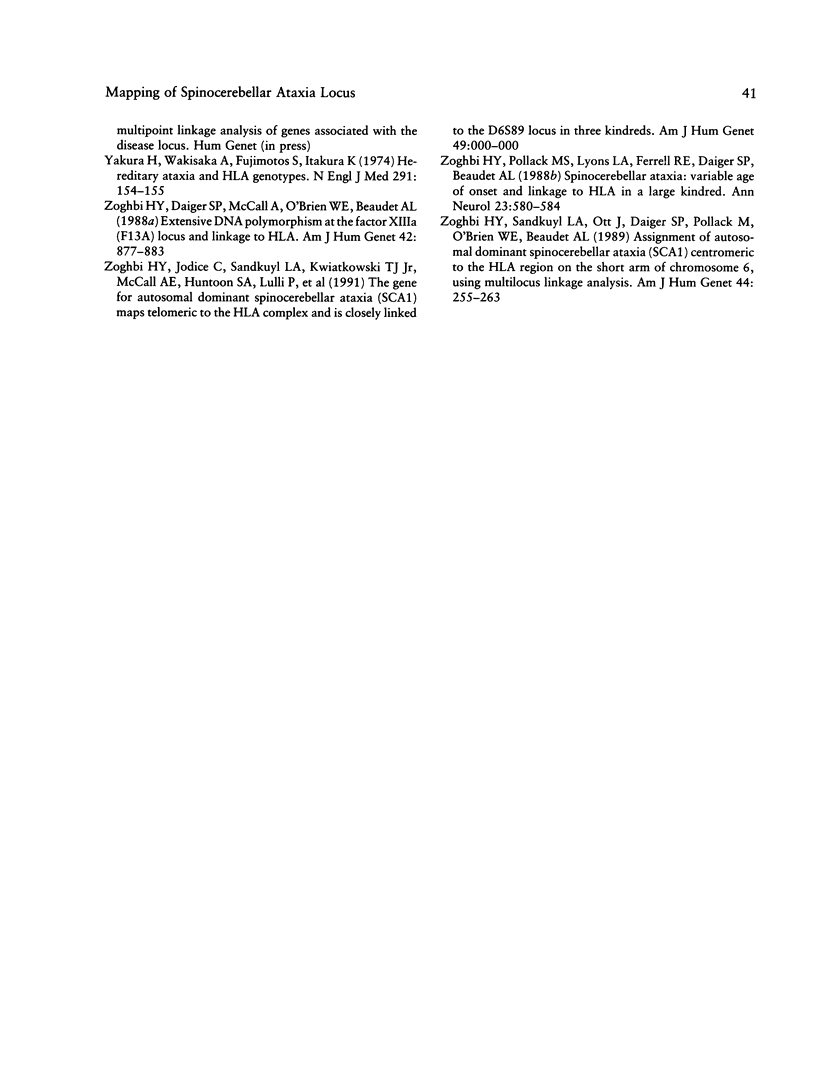
Selected References
These references are in PubMed. This may not be the complete list of references from this article.
- Auburger G., Diaz G. O., Capote R. F., Sanchez S. G., Perez M. P., del Cueto M. E., Meneses M. G., Farrall M., Williamson R., Chamberlain S. Autosomal dominant ataxia: genetic evidence for locus heterogeneity from a Cuban founder-effect population. Am J Hum Genet. 1990 Jun;46(6):1163–1177. [PMC free article] [PubMed] [Google Scholar]
- Bell G. I., Karam J. H., Rutter W. J. Polymorphic DNA region adjacent to the 5' end of the human insulin gene. Proc Natl Acad Sci U S A. 1981 Sep;78(9):5759–5763. doi: 10.1073/pnas.78.9.5759. [DOI] [PMC free article] [PubMed] [Google Scholar]
- Conneally P. M., Edwards J. H., Kidd K. K., Lalouel J. M., Morton N. E., Ott J., White R. Report of the Committee on Methods of Linkage Analysis and Reporting. Cytogenet Cell Genet. 1985;40(1-4):356–359. doi: 10.1159/000132186. [DOI] [PubMed] [Google Scholar]
- Currier R. D., Glover G., Jackson J. F., Tipton A. C. Spinocerebellar ataxia: study of a large kindred. I. General information and genetics. Neurology. 1972 Oct;22(10):1040–1043. doi: 10.1212/wnl.22.9.1040. [DOI] [PubMed] [Google Scholar]
- Duvick L., Rich S. S., Orr H. T. A polymorphic DNA probe, p1-10-2, from chromosome 6. Nucleic Acids Res. 1990 May 25;18(10):3105–3105. doi: 10.1093/nar/18.10.3105. [DOI] [PMC free article] [PubMed] [Google Scholar]
- Feinberg A. P., Vogelstein B. "A technique for radiolabeling DNA restriction endonuclease fragments to high specific activity". Addendum. Anal Biochem. 1984 Feb;137(1):266–267. doi: 10.1016/0003-2697(84)90381-6. [DOI] [PubMed] [Google Scholar]
- Grundmann U., Amann E., Zettlmeissl G., Küpper H. A. Characterization of cDNA coding for human factor XIIIa. Proc Natl Acad Sci U S A. 1986 Nov;83(21):8024–8028. doi: 10.1073/pnas.83.21.8024. [DOI] [PMC free article] [PubMed] [Google Scholar]
- Haines J. L., Schut L. J., Weitkamp L. R., Thayer M., Anderson V. E. Spinocerebellar ataxia in a large kindred: age at onset, reproduction, and genetic linkage studies. Neurology. 1984 Dec;34(12):1542–1548. doi: 10.1212/wnl.34.12.1542. [DOI] [PubMed] [Google Scholar]
- Haines J. L., Trofatter J. A. Multipoint linkage analysis of spinocerebellar ataxia and markers on chromosome 6. Genet Epidemiol. 1986;3(6):399–405. doi: 10.1002/gepi.1370030604. [DOI] [PubMed] [Google Scholar]
- Hanauer A., Chery M., Fujita R., Driesel A. J., Gilgenkrantz S., Mandel J. L. The Friedreich ataxia gene is assigned to chromosome 9q13-q21 by mapping of tightly linked markers and shows linkage disequilibrium with D9S15. Am J Hum Genet. 1990 Jan;46(1):133–137. [PMC free article] [PubMed] [Google Scholar]
- Jackson J. F., Currier R. D., Terasaki P. I., Morton N. E. Spinocerebellar ataxia and HLA linkage: risk prediction by HLA typing. N Engl J Med. 1977 May 19;296(20):1138–1141. doi: 10.1056/NEJM197705192962003. [DOI] [PubMed] [Google Scholar]
- Kumar D., Blank C. E., Gelsthorpe K. Hereditary cerebellar ataxia and genetic linkage with HLA. Hum Genet. 1986 Apr;72(4):327–332. doi: 10.1007/BF00290959. [DOI] [PubMed] [Google Scholar]
- Landis D. M., Rosenberg R. N., Landis S. C., Schut L., Nyhan W. L. Olivopontocerebellar degeneration. Clinical and ultrastructural abnormalities. Arch Neurol. 1974 Nov;31(5):295–307. doi: 10.1001/archneur.1974.00490410043003. [DOI] [PubMed] [Google Scholar]
- Lathrop G. M., Lalouel J. M., Julier C., Ott J. Strategies for multilocus linkage analysis in humans. Proc Natl Acad Sci U S A. 1984 Jun;81(11):3443–3446. doi: 10.1073/pnas.81.11.3443. [DOI] [PMC free article] [PubMed] [Google Scholar]
- Litt M., Luty J. A. Dinucleotide repeat polymorphism at the D6S89 locus. Nucleic Acids Res. 1990 Jul 25;18(14):4301–4301. doi: 10.1093/nar/18.14.4301. [DOI] [PMC free article] [PubMed] [Google Scholar]
- Marx J. L. Putting the human genome on the map. Science. 1985 Jul 12;229(4709):150–151. doi: 10.1126/science.2990043. [DOI] [PubMed] [Google Scholar]
- Morton N. E., Lalouel J. M., Jackson J. F., Currier R. D., Yee S. Linkage studies in spinocerebellar ataxia (SCA). Am J Med Genet. 1980;6(3):251–257. doi: 10.1002/ajmg.1320060309. [DOI] [PubMed] [Google Scholar]
- Nino H. E., Noreen H. J., Dubey D. P., Resch J. A., Namboodiri K., Elston R. C., Yunis E. J. A family with hereditary ataxia: HLA typing. Neurology. 1980 Jan;30(1):12–20. doi: 10.1212/wnl.30.1.12. [DOI] [PubMed] [Google Scholar]
- Ott J. Estimation of the recombination fraction in human pedigrees: efficient computation of the likelihood for human linkage studies. Am J Hum Genet. 1974 Sep;26(5):588–597. [PMC free article] [PubMed] [Google Scholar]
- Pedersen L., Platz P., Ryder L. P., Lamm L. U., Dissing J. A linkage study of hereditary ataxias and related disorders. Evidence of heterogeneity of dominant cerebellar ataxia. Hum Genet. 1980;54(3):371–383. doi: 10.1007/BF00291585. [DOI] [PubMed] [Google Scholar]
- Rich S. S., Wilkie P., Schut L., Vance G., Orr H. T. Spinocerebellar ataxia: localization of an autosomal dominant locus between two markers on human chromosome 6. Am J Hum Genet. 1987 Oct;41(4):524–531. [PMC free article] [PubMed] [Google Scholar]
- SMITH C. A. TESTING FOR HETEROGENEITY OF RECOMBINATION FRACTION VALUES IN HUMAN GENETICS. Ann Hum Genet. 1963 Nov;27:175–182. doi: 10.1111/j.1469-1809.1963.tb00210.x. [DOI] [PubMed] [Google Scholar]
- Whittington J. E., Keats B. J., Jackson J. F., Currier R. D., Terasaki P. I. Linkage studies on glyoxalase I (GLO), pepsinogen (PG), spinocerebellar ataxia (SCA1), and HLA. Cytogenet Cell Genet. 1980;28(3):145–150. doi: 10.1159/000131524. [DOI] [PubMed] [Google Scholar]
- Yakura H., Wakisaka A., Fujimoto S., Itakura K. Letter: Hereditary ataxia and HL-A. N Engl J Med. 1974 Jul 18;291(3):154–155. doi: 10.1056/NEJM197407182910314. [DOI] [PubMed] [Google Scholar]
- Zoghbi H. Y., Pollack M. S., Lyons L. A., Ferrell R. E., Daiger S. P., Beaudet A. L. Spinocerebellar ataxia: variable age of onset and linkage to human leukocyte antigen in a large kindred. Ann Neurol. 1988 Jun;23(6):580–584. doi: 10.1002/ana.410230609. [DOI] [PubMed] [Google Scholar]
- Zoghbi H. Y., Sandkuyl L. A., Ott J., Daiger S. P., Pollack M., O'Brien W. E., Beaudet A. L. Assignment of autosomal dominant spinocerebellar ataxia (SCA1) centromeric to the HLA region on the short arm of chromosome 6, using multilocus linkage analysis. Am J Hum Genet. 1989 Feb;44(2):255–263. [PMC free article] [PubMed] [Google Scholar]


